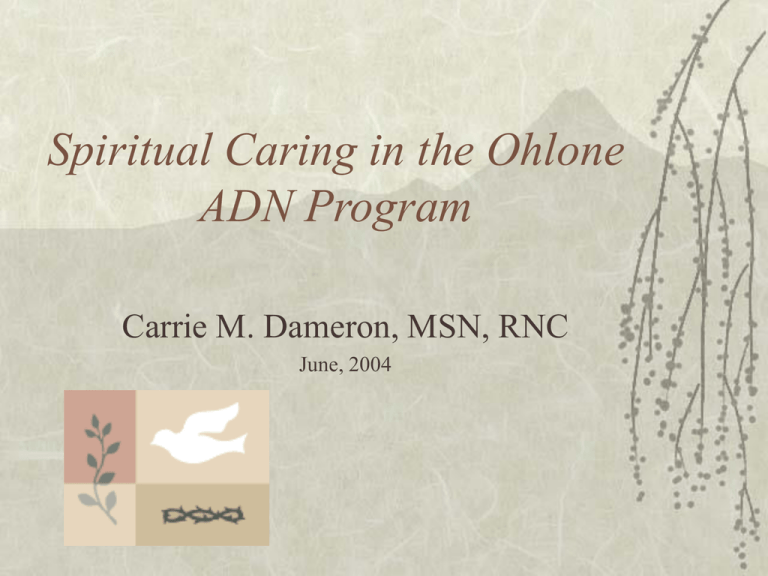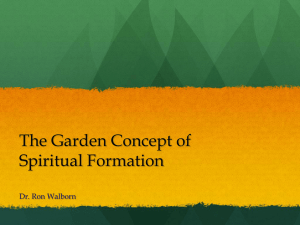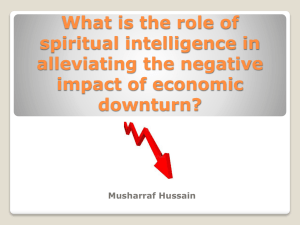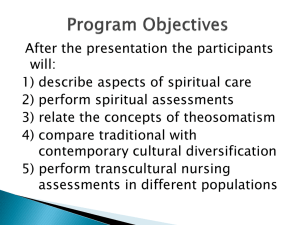Caring for patient's spiritual needs
advertisement

Spiritual Caring in the Ohlone ADN Program Carrie M. Dameron, MSN, RNC June, 2004 Spiritual Caring in the Ohlone ADN Program Nursing faculty and students recognize that people are holistic beings = physical, mental, spiritual, emotional “Considering a light bulb analogous to a human, think of the glass, aluminum, and other tangible materials that compromise it as representing the physical dimension; think of the light and warmth the bulb elicits as the psychological; and the electrical current that energizes and ultimately provides the meaning and function for the bulb as the spiritual dimension.” Stallwood & Stoll 1975 as cited by Taylor, E. F. (2002) Ohlone’s definition of Caring includes the spiritual component Caring actions are directed toward the welfare of the patient and family while focusing on health promotion, disease prevention, health restoration and management of chronic disease. This focus addresses the whole patient, bio-psychosocial and spirituality, and facilitates the movement toward a high level of wellness. A caring attitude is the respectful deference to others, positive connectedness, professional knowledge and skill and the attentiveness to another’s experience. Nursing . . . Yesterday . . . Today . . . Tomorrow Past—Florence Nightengale, and religious groups who cared for the body & soul (Egyptian priests & priestesses, monks, nuns, etc) Present—Nurses/MD’s/Spiritual Experts are researching and publishing the impact of spiritual care on medical conditions Future—An increase in spiritual based treatments and interventions interwoven with medical care for illnesses and diseases. What is spirituality? Spirituality is the essence of a being that permeates all of life. It is the life force that gives meaning to a how a person understands, views, and lives life. It is characterized by love, caring, compassion, forgiveness, and the interconnectedness with self, others, nature and God/Higher Power/Universal Life Force (Ohlone College ADN curriculum) Difference between Religion & Spirituality Religion--a system of beliefs and practices that a person can use to express their spirituality. Not required for spirituality – Examples • • • • Christians—cross, Bible Islam—Qur’an, prayer Jewish—Torah, festivals Buddhism—kharma, Buddha Remember—not all members of a religion practice, express their spirituality the same. Key Point Don’t Assume! – Inquire? Culture/Spirituality Spirituality can be – . . . determined by culture – . . . determined by life experiences unrelated to culture – . . . Influenced by both culture and personal experiences that are opposite to the cultural norm. Spiritual Development We grow spiritually, just like we grow cognitively, physically, and morally. Review of Fowler’s Stages of Faith (1984) – Faith is defined as universal human phenomenon that leads persons to need and find meaning and understanding of themselves in relation to their world • Not necessarily tied to a religion 7 Stages Undifferentiated (infant - toddler) love, hope Intuitive-projective (3-7) fantasy filled Mythic-literal (up 12) sort out fantasy/real Synthetic-conventional (adolescent-adult) incongruities, experiences Individual-reflective-examine owns faith/beliefs apart from childhood Conjunctive-appreciation for past/value self Universalizing-infrequently reached, inclusive of all people/faiths, unshackle society burdens. Spiritual Health for Ourselves and Our Patients Includes: Self—meaning & purpose, cope with life, personal dignity, love and be loved, significance, etc Others—meaning relationship with family, friends, forgiveness, etc. God/Life Force/Absolute—faith in the unseen, receive support and love, worship and serve, etc Community—contribute, fellowship, respect, participant of a vital group, etc. Holistic Caring Includes Spiritual Care Physical—bathing, massage, touch, procedures, etc Psychological— therapeutic communication, understanding, listening, etc Spiritual—presencing, empathy, praying or meditating with the patient, etc • Attending to the spiritual needs of patients is part of our daily nursing care Spiritual Care in Nursing Roy’s Adaptation Model – The moral-ethical-spiritual self is part of self-concept mode and adaptation problems in this mode can interfere with ability to heal or promote healing behaviors • (Andrews & Roy, 1986, Essentials of the Roy Adaptation Model) Nursing Mandates – JCAHO---All clients should be assessed for spiritual beliefs/practices and offered spiritual support – International Council of Nurses--Promotes environment in which human rights, values, customs, and spiritual beliefs of the individual, family and community are respected Concepts of Self-awareness /Nurse Healer Activities – Connecting, disconnecting, journeying, transforming Nonverbal/Verbal – Empathy! Presencing – Being present, being there, being with Caring – Wow, its our theme! – Potter/Perry (spiritual caring)! Spiritual Caring & The Nursing Process: Assessment Assessment FICA Model (Puchalski, 1996) Faith (believe, tradition, etc?) Important (How important to you?) Community (church, support, involvement?) Apply/Address (beliefs apply to health? how can we address those needs?) Nursing Process: Nursing Diagnose Risk for Spiritual Distress—at risk for an altered sense of harmonious connectedness with all of life and the universe in which dimensions that transcend and empower the self may be disrupted. Spiritual Distress—disruption in the life principle that pervades a persons’ entire being and that integrates and transcends one’s biological and psychosocial nature. Readiness for Enhanced Spiritual Well-Being—process of developing/unfolding of mystery through harmonious interconnectedness that springs forth from inner strengths. Nursing Process: Interventions What can I (the nurse) do?? A LOT! Active listening Bibliotherapy (reading spiritually uplifting materials, including sacred writings) Caring touch Dream analysis Expressive art (music, sculpture, painting, knitting, dance, etc) Facilitate religious practices & social support Humor Journal writing/scrapbook making Meditation Nature Praying with or for clients or assisting clients to pray Presencing Story listening, reminiscence, or life review Collaborate w/ spiritual leaders cited Taylor, E.F. (2002) Nursing Process: Evaluation Patient/client will be -less anxious -verbalize feelings, concerns, fears, etc -report feeling peace -open to discuss spiritual concerns, issues, etc Spiritual health is a PROCESS Focus on the client outcome NOT the nurse’s desired outcome. Spiritual Crisis: A crisis of illness, suffering, and/or death Many events in life can create a Spiritual Crisis. Health care: Chronic Illness, Life Threatening Trauma and/or Disease, and others Loss: of a loved one, perceived self, health, support, and others Spirituality . . . curriculum & reality Beyond the curriculum and what our students are learning, we are embracing spirituality on campus. Celebration Ceremony in remembrance of a fellow Nursing Student Music, Release of Doves, Encouraging Words Blessing of our Hands Nurse’s Day 2004 Conclusion Ohlone’s Nursing faculty and students recognize that quality, holistic nursing care includes caring for the spiritual, as well as the physical, emotional and mental needs of our patients We also recognize to care for our patients requires we first care for OURSELVES! For more information . . . Puchalski, C. M. (1996).FICA Model George Washington Institute for Spirituality and Health(http://www.gwish.org/id69.htm) Taylor, E. F. (2002) Spiritual Care: Nursing Theory, Research, and Practice. Ohlone ADN Faculty. (2004).ADN Curriculum: Professional Theme/Caring Thread






